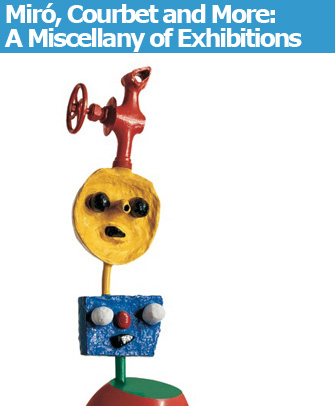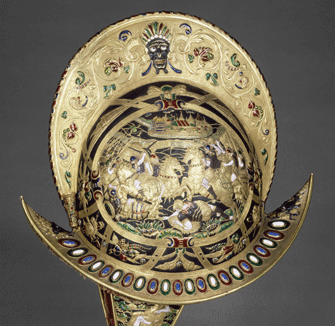 |
|
Miró’s “Jeune Fille S’évadant” (1968). © Successió Miró/Adagp, Paris 2011. Photo: Claude Germain |
Joan Miró (1893-1983), best known for his colorful, whimsical paintings, was also a prolific sculptor, to put it mildly: between the ages of 50 and …
 |
|
Miró’s “Jeune Fille S’évadant” (1968). © Successió Miró/Adagp, Paris 2011. Photo: Claude Germain |
Miró Sculpteur
Joan Miró (1893-1983), best known for his colorful, whimsical paintings, was also a prolific sculptor, to put it mildly: between the ages of 50 and 90 he made over 500 sculptures and nearly 400 pieces of ceramics, the subject of a new exhibition at Paris’s Musée Maillol. The artist, who early in his career set out to “kill painting,” wanted to create a “fantasmagoric world” with his sculptures and saw his paintings as being more conventional.
The show, with 99 sculptures, 22 ceramic pieces and 20 works on paper, offers what must be a good overview of his three-dimensional work. Many of the same whimsical ideas and images found in his paintings pop up in these works, which range from the large, rather ugly bronze “Porte III” (1974) to the Surrealistic “Jeune Fille S’évadant” (1968; pictured above), an amusing bronze, painted in his characteristic primary colors, which reduces a woman to a few elemental parts, as do many of his other sculptures: one “Woman” consists only of a box with a hole in the back topped by an egg.
Although a good percentage of these works are entitled simply “Femme” or “Personnage” (supposedly also female figures), however, many of them have some sort of phallic projection. One “Personnage,” made from found objects in 1970, gets a laugh with a barrel for a torso and a huge faucet for a penis. Miró rarely leaves whimsy behind: even one of his more menacing pieces, “Oiseau Lunaire,” of which he made many versions (this one is in plaster), seems friendly even though it bristles with tusk-like (but rounded) projections.
Miró fans will certainly enjoy this show, but while I liked quite a few pieces, notably a group of bas-reliefs from the early 1970s, I am afraid I cannot be counted among them, having once overdosed on the artist’s work at the Joan Miró Foundation in Barcelona.
Don’t miss the film in which Duke Ellington plays “Blues for Miró” in a courtyard while the artist stands next to “Oiseau Lunaire” looking uncomfortable.
Musée Maillol: 61, rue de Grenelle, 75007 Paris. Métro: Rue de Bac. Tel.: 01 42 22 59 58. Open Wednesday-Monday, 10:30am-7pm (until 9:30pm on Friday). Admission: €11. Through July 31, 2011. www.museemaillol.com
Gustave Courbet and the Love of Nature
This rather incoherent small exhibition starts off well with a group of landscape paintings by Gustave Courbet, some of them little gems, such as the powerful “La Source de la Loue” (c. 1864),
 |
|
Gustave Courbet’s “Les Amoureux dans la Campagne.” © Institut Courbet d’Ornans |
nothing more than rushing water pouring out of a hole in a rock wall and some wooden planks, and “Les Roches Noires a Trouville” (1866), with the dark rocks tumbling down on a diagonal on the left side contrasting with a placid maritime scene on the right and a sky above that is turning threatening.
The second part of the show veers off sharply into other territory, showing everything from caricatures of Courbet (a Socialist who was imprisoned for his role in the Paris Commune) in contemporary journals to portraits of him by artists and photographers, and pictures by other artists of scenes similar to those he painted. Another room offers homages to Courbet by other artists, among them Bernard Buffet.
While this is certainly not a definitive or comprehensive exhibition, it offers a pleasant interlude for Courbet lovers (who isn’t?) – and hey, it’s free!
Mona Bismarck Foundation: 34 avenue de New York, 75116, Paris. Métro: Alma-Marceau. Tel.: 01 47 23 83 37. Open Tuesday-Saturday, noon-6:30pm. Admission: free. Through June 4. www.monabismarck.org
Ethan Murrow: Momentum House
The art of drawing, unfairly seen by many as the poor cousin of painting, seems to be gaining new respect these days, and artists like the American Ethan Murrow can be given some of the
 |
|
Ethan Murrow’s “Romance BD” (2011). |
credit. His drawings are no mere sketches for heftier works (not that there’s anything wrong with that), but complex, large-format, finished works.
Drawn with graphite, the series on show at the Galerie Particulière in Paris, “Momentum House,” creates an imaginary dream world of its own. The same slightly goofy-looking character (a self-portrait), always wearing a different hat, appears in a different, impossible situation in each of these realistically drawn works, creating a mysterious world that makes the same impression that a dream would: it looks and feels real but it can’t be true.
A couple of examples: In “Cold Outside,” a man in a furry hat stares intently at the miniature house he holds in his hand. In “Romance BD,” the man’s head and shoulders pop out of a box in the foreground, and he turns his head to look directly at the viewer. The box is inside a large room with a complicated pattern on the parquet floor. The back wall is open to a seascape, with a group of people watching some sort of military boat launch. The man is alone in room with a painting of a woman in 18th-century costume on the opposite wall.
The strange situations the man finds himself and his intent curiosity about them bring to mind early explorers who would stop at nothing make new discoveries. Murrow bases the various elements in his drawings on photos, many of them taken by his wife and collaborator, Vita Weinsten, but he puts them together in ways that no camera will ever see.
Galerie Particulière: 16, rue de Perche, 75003 Paris. Tel.: 01 48 74 28 40. Open Tuesday-Saturday, 11am-7pm. Through May 7. www.lagalerieparticuliere.com
Are You Ready, Lola?
The Centre Culturel Calouste Gulbenkian, run by a foundation that promotes Portuguese culture, has a show of the recent work of a Portuguese
 |
|
Lisa Santos Silva’s “Are You Ready, Lola?” (2010). Photo: Charles Duprat |
Silva, who lives in Paris. Like Ethan Murrow (see above) she obsessively paints the same face – her own – over and over again, but in Santos Silva’s work, the face always has the same grave expression and big eyes, whether it is attached to a male or female figure. Some of them are bald, naked or armless (in “The Little Nun” and “Diamonds Are a Girl’s Best Friend”). One is dressed in an elaborate ball gown in a tribute to Velásquez’s “Las Meninas.” Two paintings – both entitled “Adieu les Colonies (Paysage) – that don’t follow this pattern are atmospheric, nearly abstract depictions of a horizon and weather (with a tornado in one). Santos Silva’s haunting works inevitably call up echos of Francis Bacon (the deformities and the painting style) and Frida Kahlo (the big, staring eyes), but they have their own distinctive presence.
Centre Culturel Calouste Gulbenkian: 51, avenue d’Iéna, 75016 Paris. Métro: Iéna. Tel.: 01 53 23 93 93. Open Monday-Friday, 9am-5:30pm, Saturday, 1pm-6pm. Admission: free. Through April 22. www.gulbenkian-paris.org
Sous l’Egide de Mars: Armures des Princes d’Europe
Suits of armor are rarely thought of as works of fine art, but the exhibition “Sous l’Egide de Mars: Armures des Princes d’Europe” at the Musée de l’Armée amply proves that they often were. During the Renaissance, when armor was becoming obsolete on the battlefield with the
 |
|
A helmet that belonged to Charles IX by Pierre Redon, c. 1570. © RMN/Daniel Arnaudet |
introduction of firearms, a suit of armor became a symbol of power and wealth. Mythological battle scenes were being refought on armor that never saw any real action to show that the king or prince who owned it was as strong as Hercules, as invincible as Mars and as clever as the Greeks who snuck into Troy inside the statue of a horse – a few of the popular themes illustrated on the suits of armor for men or horses on show here. Nearly every inch of their silver and gold-plated surfaces is covered with expertly made bas-reliefs depicting battle scenes and decorative motifs.
The craftsmanship that went into making these pieces is mind-boggling. An artist’s drawing was made, then silversmiths transferred it to the armor using the repoussée technique: these incredibly intricate images – right down to the hair on Hercules’ chest or the bricks on a château in the distance – were created by pushing on the metal from the back with special tools, then refined with chisels ion the front. Making a full suit of armor could take 10 artisans a whole year.
The brief Golden Age for French armor lasted from about 1550 to 1600. Many of these pieces were made outside of France in the Mannerist “French style,” itself inspired by the works of Italian artists like Mantegna and Raphael.
Musée de l’Armée: Hôtel National des Invalides, 129 rue de Grenelle, 75007 Paris. Métro: Invalides. Tel.: 0810 11 33 99. Open 10am-5pm through March 31, 10am-6pm thereafter (until 9pm on Tuesday). Closed first Monday of each month. Through June 26. Admission: €9. www.invalides.org
Support Paris Update by ordering books from Paris Update’s Amazon store at no extra cost. Click on your preferred Amazon location: U.K., France, U.S.
Reader Reaction: Click here to respond to this article (your response may be published on this page and is subject to editing).
More reviews of Paris art shows.
© 2011 Paris Update
